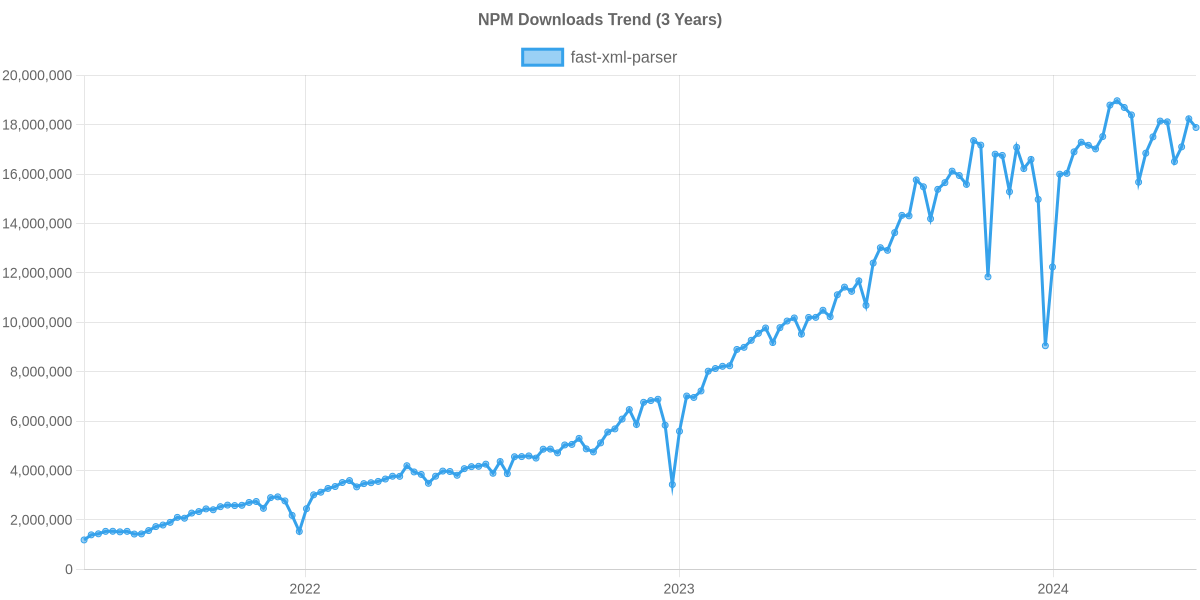Performance
- fast-xml-parser:
Fast-xml-parser is optimized for speed, making it one of the fastest XML parsers available. It minimizes overhead and efficiently converts XML strings into JavaScript objects, ideal for high-performance applications.
- sax:
Sax is designed for streaming parsing, allowing for efficient processing of large XML files without loading the entire document into memory. This makes it highly performant for big data applications.
- xmlbuilder:
Xmlbuilder's performance is generally good for generating XML, but it may not be as fast as specialized parsers for parsing tasks. Its strength lies in its intuitive API for building XML structures.
- xml2js:
Xml2js is relatively fast for smaller XML documents but may not match the speed of dedicated parsers like fast-xml-parser for larger datasets. It prioritizes ease of use over raw performance.
- xmldom:
Xmldom provides a standard DOM interface, which may introduce some performance overhead compared to lightweight parsers. Its performance is suitable for applications that require DOM manipulation.
- libxmljs2:
Libxmljs2 improves upon the performance of its predecessor, libxmljs, with optimizations that enhance speed and efficiency while maintaining feature richness.
- libxmljs:
Libxmljs offers solid performance but may not be as fast as specialized parsers like fast-xml-parser. It provides extensive features that may introduce some overhead, making it suitable for complex XML processing rather than raw speed.
Ease of Use
- fast-xml-parser:
Fast-xml-parser is straightforward to use, with a simple API that allows for quick parsing of XML strings. Its ease of integration makes it a popular choice for developers looking for speed without complexity.
- sax:
Sax requires a good understanding of event-driven programming, which may pose a challenge for beginners. However, once mastered, it offers powerful streaming capabilities for large XML files.
- xmlbuilder:
Xmlbuilder offers a fluent and intuitive API for building XML documents, making it easy for developers to create well-structured XML without extensive boilerplate code.
- xml2js:
Xml2js is designed for simplicity, making it very user-friendly for developers who need to convert XML to JavaScript objects and vice versa without delving into complex configurations.
- xmldom:
Xmldom provides a familiar DOM interface, which is advantageous for developers already accustomed to working with the DOM in web development. Its usability is enhanced by its compliance with standard DOM methods.
- libxmljs2:
Libxmljs2 retains the complexity of libxmljs but benefits from improved documentation and community support, making it slightly easier to adopt for new users familiar with XML processing.
- libxmljs:
Libxmljs has a steeper learning curve due to its comprehensive feature set. While powerful, it may require more time to understand and utilize effectively, especially for new users.
Feature Set
- fast-xml-parser:
Fast-xml-parser focuses primarily on fast parsing and does not include advanced features like XPath or XSLT. It is best suited for applications that need quick data extraction without complex manipulation requirements.
- sax:
Sax is a streaming parser that provides a minimal feature set focused on event-driven parsing. It does not support advanced XML features but excels in handling large files efficiently.
- xmlbuilder:
Xmlbuilder is focused on XML generation and provides a fluent API for building XML documents. It does not offer parsing capabilities but excels in creating well-structured XML data.
- xml2js:
Xml2js provides basic features for converting XML to JavaScript objects and vice versa. It is suitable for applications that require simple serialization without the need for complex XML features.
- xmldom:
Xmldom supports standard DOM manipulation features, allowing for comprehensive XML document handling. It is suitable for applications that require a familiar DOM interface for XML processing.
- libxmljs2:
Libxmljs2 retains the extensive feature set of libxmljs while providing better performance and ongoing support. It is a good choice for projects needing advanced XML features with improved reliability.
- libxmljs:
Libxmljs offers a rich feature set, including XPath, XSLT, and schema validation, making it suitable for complex XML document handling and manipulation. It is ideal for applications that require extensive XML processing capabilities.
Community and Support
- fast-xml-parser:
Fast-xml-parser has a growing community and is actively maintained, providing good support through documentation and community contributions. It is suitable for developers looking for a library with ongoing updates.
- sax:
Sax has a solid community and is well-documented, making it easy to find resources and examples. Its simplicity contributes to a lower barrier to entry for new users.
- xmlbuilder:
Xmlbuilder is well-documented and has a supportive community, making it easy for developers to get started with XML generation. Its intuitive API contributes to a positive user experience.
- xml2js:
Xml2js has a large user base and extensive documentation, making it easy to find help and examples. Its popularity ensures good community support for troubleshooting and best practices.
- xmldom:
Xmldom is supported by a community familiar with DOM manipulation, providing adequate resources and documentation for developers. Its compliance with standard DOM methods aids in community support.
- libxmljs2:
Libxmljs2 benefits from a more active maintenance model and community support compared to its predecessor, making it a better choice for developers seeking reliability and updates.
- libxmljs:
Libxmljs has a long-standing community with extensive documentation and examples available. However, its maintenance has been inconsistent, which may affect long-term projects.












 * Y-axis: requests per second
* Y-axis: requests per second

